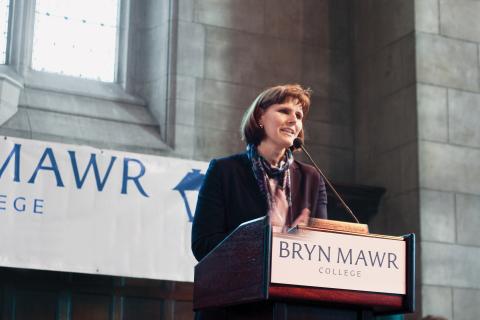Not Afraid to Be First
Women's colleges and their role in creating the next generation of leaders.

Dear Friends: The nation’s two oldest universities both had leadership changes this summer. Drew Faust stepped down as president of Harvard after serving as president for 11 years. She was the first woman to hold the job. In July, William & Mary installed their first female president, Katherine Rowe.
In addition to being world-class academics, these two trailblazing women share something else: Bryn Mawr College. Faust earned her undergraduate degree at Bryn Mawr in 1968, and Rowe worked at the College as a professor for nearly 16 years, where she also held many leadership positions before going on to be the provost at Smith College.
The fact that these two women had a connection to a college that is smaller than some high schools led me to wondering about the impact women’s colleges have had on higher education’s leadership landscape, either through fostering the growth of faculty/administrators or the achievements of our alumnae/i.
While I did not do an exhaustive search, I quickly noted that the first woman president of many of the nation’s top colleges and universities either attended or worked at a women’s college. Some of these institutions include the University of Chicago (Hanna Holborn Gray ’50 was the first woman president of an R1 university), Brown University, U.C. Berkeley, Oberlin College, and Trinity College.
Among the top 100 liberal arts colleges, 36 are currently run by women, and more than 25 percent (11) of these women attended or worked at a women’s college prior to becoming president. These percentages are substantially higher than the overall percentage of women who attend or work at women’s colleges—even after considering that decades ago women had fewer educational or academic position options.
One of the questions that I am often asked is whether being in an environment focused on women is actually detrimental to women’s success because it creates conditions that are “not like the real world,” a world where women face many challenges, biases, obstacles, and even harassment. As our community knows, at Bryn Mawr women’s success is assumed, high expectations mean high expectations for women, and women are empowered and positioned to do everything. In my experience, spending time in such an environment raises expectations, builds confidence, and teaches women not to accept limits or to tolerate bias.
From college presidencies to national politics (first women to serve as Secretary of State and Speaker of the House, to name just a few) to heading labs and theater companies, women with experience at a women’s college are trailblazers and not afraid to be the first.
There is still much work to be done. As the #MeToo movement has shown, workplace harassment continues to be an all-too-common occurrence. The most senior executive level in nearly all industries continues to be overwhelmingly the exclusive domain of white men, and women from underrepresented racial and ethnic groups face multiple forms of discrimination in pursuit of their professional aspirations. Women’s colleges have an important role to play as advocates for inclusive gender equity across professions and around the world. Bryn Mawr played just such a role in hosting a bi-partisan forum this fall for women running for Congress in Pennsylvania while calling attention to the low percentage of women serving in elected office across the Commonwealth.
I am proud of the role women’s colleges play in creating the next generation of leaders and of our power to call attention to issues of gender equity and gender inclusion. I am confident that our current students, faculty, and staff will continue to lead the fight for equality.
Sincerely,
Kim Cassidy
President
Published on: 11/14/2018
